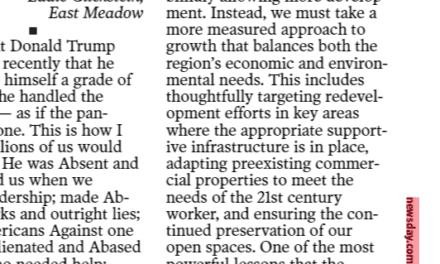The following was read for the public record on February 26, 2015
Good afternoon.
My name is Richard Murdocco. I am a lifelong Long Islander, and at 28, am a young professional who is currently building a life in the region. I have my Masters in Public Policy from SUNY Stony Brook, where I studied housing and transportation issues, as well as regional and environmental planning with Dr. Koppelman, Long Island’s veteran planner. I regularly write on land use policy and economic development issues, with my work appearing in Newsday, Long Island Business News, The Long Island Press, Pacific Standard Magazine and various other regional and national publications.
I am here today to present a vision of Nassau County that runs counter to a narrative that has slowly been established over the last ten years. The Comptroller’s report cites stagnant population growth in the County from the year 2000 to 2013, but it’s important to remember that Nassau’s population has been relatively unchanged since the 1970’s. Comparing fast-growing Queens, or Suffolk, with its 42,000 acres of vacant open space and half the population density, to Nassau, an older suburb, is unproductive. With just over 4,000 acres of vacant land, Nassau’s land use patterns are set, and the opportunity to shoehorn more people is limited thanks to environmental and infrastructure limitations. By trying to attract more people, the County is wasting energies that can be put forth attracting new industries.
In creating a sustainable economic plan, it is important to not get caught up in generalizations and anecdotal analysis of demographic trends, but rather base the vision on the best available data sets, and proper, professional analysis.
The comptrollers report does have its merits. Creating a cluster of medical and healthcare industries would be a worthwhile endeavor, but we need to go beyond those efforts. A region needs to be insulated from larger economic and demographic shifts, and investment in just one industry is a risky proposition. When Grumman scaled down their operations in the late 1980’s, the regional economy was left reeling. This highlights the vulnerability of “putting our eggs” in one basket. The County needs any vision put forth to have a diverse, multi-faceted economy that can withstand multiple periods of growth and recession.
To echo the sentiments shared by the most recent Long Island Index Report, our investment in the biomedical industries must focus on our region’s unique existing assets and research centers.
It should be the goal of the County not to compete with New York City to the west or Suffolk to the east, but rather create a strategy that complements the strengths of these areas, while filling the gaps of regional needs. The economic vision must include an honest assessment of what the County has, what it needs and realistic ways to implement its goals.
Further, it must rise above the noise put forth by stakeholder groups with a vested interest in pursuing one approach over another. These groups favor buzzwords over analysis, as well as narratives over on-the-ground realities and the needs and wants of residents.
The comptroller’s report is a good step in the right direction, but there is still much work to be done.













